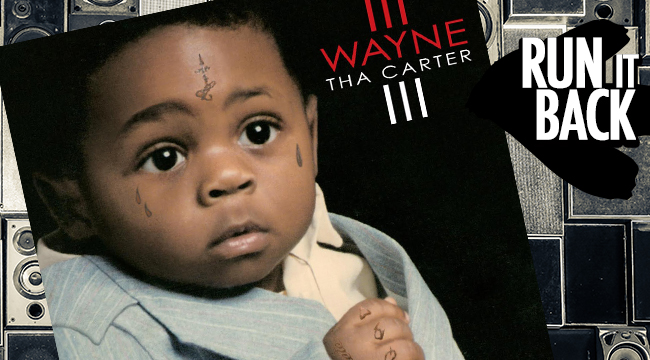
Run It Back is a retrospective review of classic or game-changing hip-hop releases whose style and sound still resonate with listeners in the modern, streaming-driven era. Hip-hop has always been a forward-facing, youth-oriented culture, but it’s also deeply informed by the past. This is our way of bridging the gap, paying homage to rap’s roots while exploring how they still hold relevance today.
In 2008, you couldn’t go anywhere online without hearing “A Milli” or one of its approximately 5,878 incarnations, whether “remixes” or freestyles. The song boomed across blacktop basketball courts and out of car radios, and its video practically dominated the final days of music video television shows.
It might be safe to say it was both the first ubiquitous rap hit of the digital age and the last of the prior era. It made Lil Wayne a household name across America — while he was well-known in urban pockets where hip-hop stations reigned supreme, “A Milli” and its parent album, Tha Carter III, constituted many folks’ first exposure to Weezy F. Baby and his screwball, absurdist approach to rapid-fire, stream-of-conscious punchlines. As a result, he became one of the most recognizable faces in rap, and an inspiration for an entire generation of rappers that was soon to follow. However, the album that houses that game-changing whirlwind of a hit doesn’t quite live up to its outsized impact.
It has its high points of course. Despite “A Milli” holding an exalted position as the highlight of the album due to its insane reception, that distinction actually belongs to emotional centerpiece “Tie My Hands,” featuring none other than Robin Thicke. A heartfelt ode to Wayne’s hometown of New Orleans in the wake of Hurricane Katrina, the song is at once a defiant declaration of the city’s resilience in the face of adversity and a mournful elegy for the resultant loss and devastation the storm left behind.
Another highlight is “Dr. Carter,” a surgical, scalpel-sharp deconstruction of the “Hip-Hop Is Dead” trope that dominated discussion at the dawn of the blog rap era (and has continued to do so in some form ever since) that finds Weezy both refuting the long-held refrain of the ringtone rap movement’s detractors and symbolically setting the stage for the genre’s nascent next evolution slowly building on websites like HipHopDX and NahRight.
Meanwhile, “Let The Beat Build” and “Mr. Carter,” as well as the album’s menacing intro “3 Peat,” all elaborate on the formula established by “A Milli,” with a freewheeling sensibility that hearkens back to rap’s early days, the generation of braggadocious freestyle raps traded in parks and on street corners. Wayne’s best punchlines surprise and amuse, with sly twists on established turns-of-phrase and off-the-wall, surreal imagery that makes these tracks instant rewind button fodder, requiring multiple listens to catch each example of his sparkling wordplay.
Unfortunately, the quantity of such rhymes tends to detract from the overall quality, as he fills other parts of the album with goofy duds. Consider the downright lazy wordplay on display in “Got Money”: “Bitch, I’m the bomb like, ‘Tick, tick.’” The pattern wears thin after “Let The Beat Build,” as each progressive track begins to blur together and the schtick sounds even more tired on the less-than-inspired beats that populate the back third of Tha Carter III. “Lollipop,” the album’s lead single, also contributed as much to the autotuned crooning trend that would eventually overtake hip-hop’s most prominent output, but comes off sounding out-of-place, overproduced, and irritatingly repetitive thanks to its placement.
If The Carter III were trimmed to the first ten tracks, it might be an undisputable, ineffable classic based on quality as much as impact, even with Bobby Valentino imitating a police siren on “Mrs. Officer” and the overcooked bombast of “Phone Home.” As it is, it’s a lot like Wayne himself, an exercise in excess, being pulled in too many different directions at once and containing far too many ideas to execute any single one of them truly excellently, other than “Tie My Hands,” “Dr. Carter,” and, of course, “A Milli.”
A tighter tracklist could have served to mitigate some of Wayne’s spaced-out wackiness, but then it wouldn’t really feel like a Lil Wayne album, which almost needs too much of everything to even qualify. Maybe that’s why it had and has such an all-encompassing and long-lasting influence over rap music, even to this day. No matter what kind of rap you like — lyrical, melodic, conceptual, or throw-everything-at-the-wall-and-see-what-sticks quirky — you can trace at least a thread of its roots to Tha Carter III.
Wayne may have peaked in 2008 and never reached the same heights again, but every plateau the genre has achieved since has been by standing on his gigantic, creative shoulders.






